|
| |
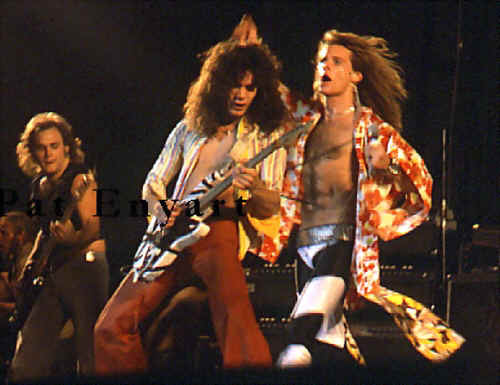
With their 1978 eponymous debut, Van Halen simultaneously rewrote the rules of rock
guitar and hard rock in general. Guitarist Eddie Van Halen redefined what electric guitar
could do, developing a blindingly fast technique with a variety of self-taught two-handed
tapping, hammer-ons, pull-offs, and effects that mimicked the sounds of machines and
animals. It was wildly inventive and over the top, equaled only by vocalist David Lee
Roth, who brought the role of a metal singer to near-performance art standards. Roth
wasn't blessed with great technique, unlike Eddie, but he had a flair for showmanship that
was derived as much from lounge performers as Robert Plant. Together, they made Van Halen
into the most popular American rock & roll band of the late '70s and early '80s, and
in the process set the template for hard rock and heavy metal for the '80s. Throughout the
'80s, it was impossible not to hear Van Halen's instrumental technique on records that
ranged from the heaviest metal to soft pop. Furthermore, Roth's irony-drenched antics were
copied by singers who took everything literally. One of these was Sammy Hagar, an arena
rock veteran from the '70s who replaced Roth after the vocalist had a falling out with Van
Halen in 1985. Hagar stayed with the band longer than Roth, helping the group top the
charts through the late '80s and early '90s. However, the group's sales began to slide in
the mid-'90s, just as tensions between Hagar and Eddie began to arise. In one of the most
disastrous publicity stunts in rock history, Hagar was fired (or quit) and Roth was
brought back on, seemingly as a permanent member, but only for two songs on a
greatest-hits album. He was subsequently replaced by Gary Cherone, a former member of
Extreme. Through all the upheaval over lead vocalists, Eddie Van Halen and his prodigious
talent remained the core of Van Halen. The son of a Dutch bandleader, Eddie and his family
moved from the Netherlands to Pasadena, CA, in 1967, when he was 12 years old and his
older brother, Alex, was 14. As their father supported the family by playing in wedding
bands, Eddie and Alex continued their classical piano training. Soon, both boys were
enraptured by rock & roll. Eddie learned how to play drums and Alex took up the
guitar, eventually switching instruments. The brothers began a hard rock band called
Mammoth and began playing around Pasadena, eventually meeting David Lee Roth. At the time,
Roth, who had been raised in a wealthy Californian family, was singing in Redball Jet.
Impressed by the Van Halen brothers, he joined forces with the group. Shortly afterward,
bassist Michael Anthony, who was singing with Snake, became a member of Mammoth. After
discovering that another band had the rights to the name Mammoth, the group decided to
call themselves Van Halen in 1974, rejecting the proposed Rat Salade. For the next three
years, Van Halen played throughout Pasadena, Santa Barbara, and Los Angeles, playing both
clubs and hotel bars. The band's repertoire covered everything from pop and rock to disco,
but they eventually worked in their own original material. Within a few years, they had
become the most popular local band in Los Angeles, and Eddie became well known for his
groundbreaking technique. In 1977, Kiss' Gene Simmons financed a demo recording session
for Van Halen after seeing them at the Starwood Club. On the strength of Simmons'
recommendation, Mo Ostin and Ted Templeman signed Van Halen to Warner Bros., releasing the
band's debut the following year. Van Halen became a hit due to strong word of mouth,
constant touring, and support from AOR radio. Within three months the album had gone gold,
and five months later it went platinum. It would eventually sell over six million copies,
thanks to the album rock staples "You Really Got Me," "Jamie's
Cryin'," and "Runnin' With the Devil." Van Halen II, released in 1979,
continued the band's success, as "Dance the Night Away" became their first Top
20 single. Women and Children First (1980) didn't have any charting singles, but was a
success on the album charts, reaching number six. The band supported the album with their
first headlining, international arena tour, and the group was quickly on their way to
being superstars. Released in 1981, Fair Warning wasn't quite as popular as their previous
records, yet it still peaked at number six. Diver Down, released in 1982, was a huge hit,
spawning a number 12 cover of Roy Orbison's "(Oh) Pretty Woman" and reaching
number three. While all of their previous albums were successful, Van Halen didn't become
superstars until 1984, when their album 1984 became an across-the-board smash. Released on
New Year's Day, 1984 rocketed to number two on the strength of the number one single
"Jump." Like many songs on the album, "Jump" was driven by Eddie's new
synthesizer, and while Roth was initially reluctant to use electronics, the expansion of
the group's sound was widely praised. Throughout 1984, Van Halen gained steam, as
"I'll Wait" and "Panama" became Top 15 singles and "Hot for
Teacher" became a radio and MTV staple. Despite the band's breakthrough success,
things were not well within the band. During their 1984 tour, each member played separate
solo sets and were physically separated on the stage. Roth was unhappy with Eddie's
appearance on Michael Jackson's 1983 hit "Beat It," and Van Halen grew tired of
the comic antics of Roth. In 1985, Roth released a solo EP, Crazy From the Heat, which
spawned hit covers of "California Girls" and "Just a Gigolo/I Ain't Got
Nobody." When Roth delayed the recording of Van Halen's follow-up to 1984, he was
fired from the band. Most observers were taken by surprise when Van Halen named Sammy
Hagar as Roth's replacement. The former lead singer of Montrose, Hagar's solo career had
been sporadically successful, highlighted by such arena metal hits as "Three-Lock
Box" and "I Can't Drive 55." Though many critics suspected Hagar wouldn't
be able to sustain Van Halen's remarkable success, his first album with the band, 1986's
5150, was a huge hit, reaching number one and spawning the hit singles "Why Can't
This Be Love," "Dreams," and "Love Walks In." Released in 1988,
OU812 was just as successful, earning stronger reviews than its predecessor and generating
the hits "When It's Love" and "Finish What You Started." For Unlawful
Carnal Knowledge, released in 1991, was another number one hit, partially due to the hit
MTV video for "Right Now." Van Halen followed the album with their first live
record, the double album Van Halen Live: Right Here, Right Now in 1993. By the spring 1995
release of Balance, tensions between Eddie Van Halen and Sammy Hagar had grown
considerably. Eddie Van Halen had recently undergone well-publicized treatment for
alcoholism, and Hagar was notorious for his party-hearty ways, even writing a paean to
Amsterdam's hash bars with "Amsterdam" on Balance. Furthermore, the band had
become subject to criticism that they simply repeated a formula. While Balance was
successful, entering the charts at number one and selling two million copies shortly after
its release, it stalled quickly afterward. The band wanted to release a greatest-hits
collection, but Hagar balked at the idea, escalating tensions even further. Following a
skirmish in 1996 over the recording of a song for the Twister soundtrack, Eddie decided to
make a change by switching singers. Van Halen began recording new material with Roth
without informing Hagar, who went ballistic upon learning of the group's reunion.
According to Hagar, Eddie fired him shortly afterward; Van Halen claimed Hagar quit. Roth
proceeded to record two new songs for Van Halen's Best Of, Vol. 1, and once the reunion
became public, the rock media reacted positively to the news; MTV began airing a welcome
back commercial days after the announcement. However, the reunion was not to be. Following
an appearance at the MTV Music Awards, Van Halen fired Roth from the band, claiming that
he was only on board to record two new songs. Roth said that he was duped into recording
the songs, believing that the reunion was permanent. Former Extreme vocalist Gary Cherone
was announced as the band's new lead singer. Though the resulting Best Of, Vol. 1 was a
success, Eddie Van Halen's reputation as a nice guy was tarnished once the entire affair
was over. Cherone's long-awaited debut with Van Halen, entitled Van Halen III, was finally
released in March of 1998. Although the album debuted high on the charts, crashing in at
number three, it quickly slipped down the charts, since the reception to the album from
fans, critics, and radio was mixed.
After Van Halen III proved to be the worst-selling album of Van Halen's long and
illustrious career (the ensuing world tour was poorly attended as well), Cherone was
dismissed from V.H. in 1999. Immediately, rumors began to swirl once more of an impending
David Lee Roth/Van Halen reunion. Things were kept completely hush-hush in the V.H. camp
until early 2001, when David Lee Roth went public on his website with an update,
confirming that he had recorded several new songs with the band (tracks that Roth
described as amazing, phenomenal, and astonishing), but hadn't heard back from them since
the previous summer. Only a few days after Roth's news, Eddie Van Halen admitted to the
public that he was battling cancer, but was told by his doctors that chances were good for
a complete recovery. In the summer of 2001, Eddie told MTV News that V.H.'s remaining
members had penned a total of three albums worth of new material and that they were still
unsure of who their next singer would be. Months later, fans were shocked to hear that the
band parted ways with Warner Brothers, their label since 1979. The band blamed the label
for promoting younger bands, while also admitting that they had not yet found Cherone's
replacement and were no longer considering Roth.

Van Halen - 1978
Van Halen's self-titled 1978 debut is undoubtedly one of the all-time best debuts by a
hard rock/heavy metal band. All of the components for a classic are represented -
excellent songs and high-octane performances (the excitement of their live show was
captured perfectly by producer Ted Templeman) are used to create an invigorating, original
sound. Like other acclaimed debuts (Led Zeppelin I, Are You Experienced?), Van Halen has a
raw edge since it was recorded quickly, and every single song is a winner. It's also
become one of the ultimate party albums over the years, since the overall mood is excited
and celebratory. While singer David Lee Roth's bravado and the steady rhythm section of
drummer Alex Van Halen and bassist Michael Anthony were both key ingredients, the main
attraction was Eddie Van Halen's guitar playing. Few other guitarists have had such an
instant impact on a generation of up-and-coming players, who copied his unorthodox,
kamikaze style - especially his trademark tapping technique showcased on the album's
legendary solo "Eruption." Almost all of the tracks on Van Halen have rightfully
become radio staples, such as the scorching rockers "Runnin' With the Devil,"
"Ain't Talkin' 'Bout Love," "Jamie's Cryin'," "Atomic Punk,"
and "On Fire," while covers of "You Really Got Me" and "Ice Cream
Man" remain awe-inspiring to this day. Van Halen proved to be the ultimate
coming-of-age soundtrack to many a teenager since its release, resulting in sales of over
10 million in the U.S. alone. Everyone on the planet should own a copy of this landmark
release. - Greg Prato
01 - (3:37) Runnin' With The Devil
02 - (1:43) Eruption
03 - (2:39) You Really Got Me
04 - (3:51) Ain't Talkin' 'Bout Love
05 - (3:47) I'm The One
06 - (3:31) Jamie's Cryin'
07 - (3:02) Atomic Punk
08 - (3:44) Feel Your Love Tonight
09 - (3:24) Little Dreamer
10 - (3:21) Ice Cream Man
11 - (3:02) On Fire


Van Halen II - 1979
Rather than take an extended break after spending nearly a year on the road promoting
their exceptional 1978 debut, Van Halen went directly back into the studio to record
another album. 1979's Van Halen II was just as intense as its predecessor, but wasn't as
potent compositionally - which is forgivable since it was nearly impossible to top Van
Halen. A very brief album (barely over 30 minutes in length), Van Halen II spawned the
group's first true hit single, the aptly titled Top 20 hit "Dance the Night
Away," while featuring another strong set of turbo-charged rock. A mid-paced cover of
"You're No Good" (originally popularized by Linda Ronstadt) kicks things off,
before the band's rowdy party rock regains shape - "Somebody Get Me a Doctor,"
"Bottoms Up!," "Outta Love Again," "Light Up the Sky," and
"D.O.A." are all testosterone-heavy ragers. In addition to the aforementioned
"Dance the Night Away," the album closer "Beautiful Girls" showed VH's
burgeoning pop sensibilities, while Eddie Van Halen showcases his guitar chops again on
the acoustic "Spanish Fly" and the exquisite intro to the sullen "Women In
Love." Van Halen II confirmed that the band was fast becoming America's premier hard
rock/metal band. - Greg Prato
01 - (3:18) You're No Good
02 - (3:10) Dance The Night Away
03 - (2:55) Somebody Get Me A Doctor
04 - (3:08) Bottoms Up!
05 - (2:54) Outta Love Again
06 - (3:13) Light Up The Sky
07 - (1:02) Spanish Fly
08 - (4:12) D.O.A.
09 - (4:10) Women In Love
10 - (3:57) Beautiful Girls

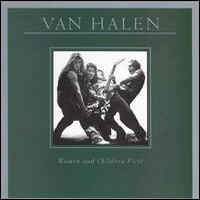
Women And Children First - 1980
By Van Halen's third release, 1980's Women and Children First, the group was a bona
fide arena headliner; hence, meaty guitar riffs and a huge, fat sound are featured
throughout. While Van Halen II was closely rooted both compositionally and sonically to
their self-titled debut, Women and Children First signaled the band's first (successful)
attempt to branch out. The tracks may not have been as immediate as such previous
favorites as "Runnin' With the Devil" or "Dance the Night Away," but
they were much more ambitious from a songwriting standpoint, resulting in perhaps Van
Halen's most underrated record. The anthemic album opener, "And the Cradle Will
Rock...," was the first Van Halen track to ever feature keyboards (processed through
a guitar amplifier for a heavy sound), while the massive yet spacious sound of such heavy
hitters as "Everybody Wants Some!," "Fools," "Romeo
Delight," and "Loss of Control" is simply awe-inspiring. Both the intro to
"Take Your Whiskey Home" and "Could This Be Magic?" find the band in a
loose and fun bluesy mode, while the album-closing epic ballad "In a Simple
Rhyme" is one of Van Halen's all-time best and deserved to be a hit. An
oft-overlooked hard rock classic. - Greg Prato
1 - (3:35) And The Cradle Will Rock
2 - (5:10) Everybody Wants Some!!
3 - (5:59) Fools
4 - (4:22) Romeo Delight
5 - (0:57) Tora! Tora!
6 - (2:40) Loss Of Control
7 - (3:13) Take Your Whiskey Home
8 - (3:11) Could This Be Magic?
9 - (4:42) In A Simple Rhyme

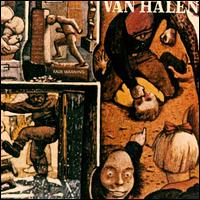
Fair Warning - 1981
Although Van Halen were enjoying an enormous amount of commercial success by 1981, not
all was happy in the VH camp. While the public believed that the euphoric, party-hearty
antics of their live show spilled into their personal lives, this proved not to be case.
Edward Van Halen was feeling frustrated due to the group's unwillingness to branch out
musically as much as he desired, resulting in the group's darkest album, Fair Warning.
Unlike Van Halen's other Roth-era albums, not a single party anthem was included - in its
place was an unmistakable feeling of strife and friction, both lyrically and musically.
The album opener, "Mean Street," contains a furious guitar intro by Eddie,
before leading into one of VH's funkiest grooves. While the mood is eased from time to
time throughout ("Dirty Movies," "Hear About It Later," "Push
Comes to Shove"), the album is simply an unapologetic ass-kicker - "Sinner's
Swing!," "Unchained," "So This Is Love?," and "One Foot Out
the Door" capture the band at their red-hot fiercest. Along with their self-titled
debut and 1984, Fair Warning is an undisputed Van Halen masterpiece. - Greg Prato
1 - (5:03) Mean Street
2 - (4:09) Dirty Movies
3 - (3:11) Sinner's Swing!
4 - (4:36) Hear About It Later
5 - (3:31) Unchained
6 - (3:50) Push Comes To Shove
7 - (3:08) So This Is Love?
8 - (1:59) Sunday Afternoon In The Park
9 - (1:58) One Foot Out The Door

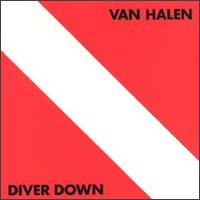
Diver Down - 1982
Although it went platinum, Fair Warning didn't match the multi-platinum standards of
Van Halen's first three records, so the group revamped their sound slightly for the
follow-up, Diver Down. Adding the slightest hints of synthesizers and streamlining both
the guitar indulgences of Eddie Van Halen and the vocal excesses of David Lee Roth, the
album contained some of the group's most pop-oriented performances - and they were all in
the guise of covers. "(Oh) Pretty Woman" and "Dancing in the Street"
had the traditional mechanical Van Halen rhythmic pulse, as well as concise solos from
Eddie and restrained vocals from Diamond Dave, which helped them become the hits they were
designed to be. If they were offset by more original material like "Hang 'Em
High," the concessions would have been acceptable, but the rest of Diver Down is
filled with covers, including "Big Bad Bill," "Where Have All the Good
Times Gone," and a closing "Happy Trails." All of the songs are
professionally performed, and the music features more ideas than most previous Van Halen
albums, but the lack of strong original material makes Diver Down less of an
accomplishment than it appears. - Stephen Thomas Erlewine
01 - (3:05) Where Have All The Good Times Gone?
02 - (3:29) Hang 'Em High
03 - (1:23) Cathedral
04 - (3:28) Secrets
05 - (1:41) Intruder
06 - (2:56) Oh, Pretty Woman
07 - (3:47) Dancing In The Street
08 - (0:42) Little Guitars (Intro)
09 - (3:50) Little Guitars
10 - (2:46) Big Bad Bill [Is Sweet William Now]
11 - (3:23) The Full Bug
12 - (1:04) Happy Trails

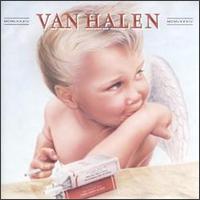
1984 - 1984
Van Halen's 1984 is arguably the best and most defining rock release of the '80s. Eddie
Van Halen's guest appearance on Michael Jackson's massive 1983 hit "Beat It"
introduced VH to the pop audience, which the band attracted in droves with this expertly
crafted set of hard rock with pop leanings, not to mention its imaginative accompanying
videos. Musically, 1984 was a gamble that paid off massively - Eddie Van Halen was finally
given the green light by his bandmates to incorporate keyboards into their sonic palette,
resulting in the number one single "Jump" and the almost new wave-ish Top 15
love song "I'll Wait." But wisely, the keyboards weren't overpowering, and all
of the other selections were typical VH hard-rocking heavies - the perennial radio
favorites "Hot for Teacher" and "Panama," as well as the highly
underrated album tracks "Top Jimmy," "Drop Dead Legs," "Girl Gone
Bad," and "House of Pain." While the strong and instantly memorable songs
were obviously the main ingredient for the album's success, a string of imaginative and
humorous videos really introduced the band to a whole new audience (the hilarious clip for
"Hot for Teacher" has to be one of the all-time best). 1984 also opened up the
floodgates for many faceless, identical pop-metal bands (something VH was the complete
opposite of), who suddenly realized that adding synths to heavy metal could increase their
chances of commercial success. Still, it didn't tarnish the fact that 1984 is a timeless
hard rock masterpiece, which eventually sold a staggering ten million copies.
Unfortunately, the album would be the last Van Halen recording to feature David Lee Roth,
who surprisingly left in 1985 at the height of the band's popularity. - Greg Prato
1 - (1:08) 1984
2 - (4:04) Jump
3 - (3:34) Panama
4 - (3:03) Top Jimmy
5 - (4:15) Drop Dead Legs
6 - (4:46) Hot For Teacher
7 - (4:45) I'll Wait
8 - (4:36) Girl Gone Bad
9 - (3:19) House Of Pain


5150 - 1986
Few bands in rock history made as seamless a transition between lead vocalists as Van
Halen. A platinum solo act in his own right, Sammy Hagar brought proven star power, a huge
set of pipes, and an immediate air of confidence to the proceedings that no true newcomer
could have ever hoped to deliver. On the down side, this seemingly perfect marriage would
ignite a vicious feud between David Lee Roth loyalists, Hagar fans, and within the Van
Halen creative/management camp as well. Thankfully, both sides would deliver in spades.
5150 (named after Eddie's home studio) became a number one blockbuster record with a
sold-out tour to boot. Hagar ushered in the new era with an amazingly Roth-sounding squeal
announcing the heavily sardonic "Good Enough" - a rousing number with all the
classic VH trappings. The band set charts on fire with the massive first single "Why
Can't This Be Love," equally loved and reviled by the band's old-school fans for its
pervasively synth-laden sound. The band segues effortlessly from the frenzied "Get
Up" into the soaring commercial anthem "Dreams," culminating with the
stream-of-consciousness barroom chatter of album closer "Inside." In between,
they serve up a trio of convincing rockers in "Summer Nights," "Best of
Both Worlds," and the title track, as well as another outstanding power ballad,
"Love Walks In." Even though 5150 sounded radically different from its
predecessor, upon closer examination, its songs are clearly an extension of 1984's
blueprint. The drums may sound different, the band may be mixed differently, but the
intrinsic classic VH guitar attack remains intact. Technically a near-perfect collection
of pop-minded rock anthems, 5150 still divides Van Halen fans to this day. Roth-era
loyalists may balk at the album's contrived sleekness, but the overwhelming quality and
consistency of its material is still undeniable. - Ed Rivadavia & John Franck
1 - (4:06) Good Enough
2 - (3:49) Why Can't This Be Love?
3 - (4:38) Get Up
4 - (4:55) Dreams
5 - (5:07) Summer Nights
6 - (4:50) Best Of Both Worlds
7 - (5:12) Love Walks In
8 - (5:46) 5150
9 - (5:03) Inside

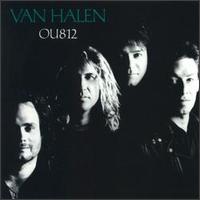
OU812 - 1988
Van Halen broke open the pop innovations of 5150 with OU812, their second album with
Sammy Hagar. On OU812, Hagar's direct approach is fully incorporated into the group, as
the band churns out straightahead heavy rockers like "Black and Blue" and
pulsing power ballads like "Feels So Good." Under Eddie's direction, the group
adds a couple of stylistic quirks - from the chicken-picking of "Finish What You
Started" and the Hawaiian flourishes of "Cabo Wabo" to the driving,
jazz-inflected metallic "Mine All Mine" - which make OU812 one of the band's
most intriguing and rewarding albums. - Stephen Thomas Erlewine
01 - (5:16) Mine All Mine
02 - (5:41) When It's Love
03 - (4:32) A.F.U. (Naturally Wired)
04 - (7:06) Cabo Wabo
05 - (4:03) Source Of Infection
06 - (4:33) Feels So Good
07 - (4:26) Finish What Ya Started
08 - (5:28) Black And Blue
09 - (5:57) Sucker In A 3 Piece
10 - (3:53) A Apolitical Blues

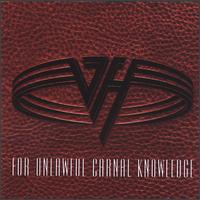
For Unlawful Carnal Knowledge - 1991
The smirking title indicates the true nature of For Unlawful Carnal Knowledge, Van
Halen's third album with Sammy Hagar. Backing away from the diversity of OU812, the band
turns in some of the most basic, straightforward rock & roll of their career. At
times, F.U.C.K. recalls the sleek hard rock of Hagar's early-'80s albums, and it's
undeniable that his limited vocal power had a great deal to do with the obvious nature of
most of this music. While the band is still tight and professional - and Eddie's
guitar-work remains impressive - the songwriting is, by and large, undistinguished, with
the anthemic "Right Now" standing out as the most memorable song of the batch,
mainly because of its incessant chorus. - Stephen Thomas Erlewine
01 - (5:22) Poundcake
02 - (4:40) Judgement Day
03 - (4:54) Spanked
04 - (4:22) Runaround
05 - (7:00) Pleasure Dome
06 - (6:06) In 'N' Out
07 - (5:05) Man On A Mission
08 - (4:00) The Dream Is Over
09 - (5:23) Right Now
10 - (1:30) 316
11 - (3:54) Top Of The World

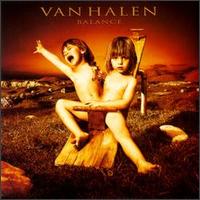
Balance - 1995
Balance tries to open up the Van Hagar formula somewhat. Eddie Van Halen sincerely
attempts to improve the group musically, by adding more subtle and assured ballads and
more fearless rockers. No matter how hard he tries, he's weighed down by the most
predictable rhythm section in all of rock & roll, which gives each number the same
unvarying deadlocked pulse, completely obliterating Eddie's increased musical sensitivity.
Of course, he isn't helped by Hagar, either. Hagar also tries to follow the social
conscious that served him so well on "Right Now," as the first single
"(Don't Tell Me What) Love Can Do." Unfortunately, he can't help himself and
slips back to the raucous partying of "Amsterdam" - you know, the place where
they're allowed to smoke pot and stuff. - Stephen Thomas Erlewine
01 - (5:20) The Seventh Seal
02 - (4:09) Can't Stop Lovin' You
03 - (5:58) Don't Tell Me (What Love Can Do)
04 - (4:46) Amsterdam
05 - (3:58) Big Fat Money
06 - (1:29) Strung Out [Instrumental]
07 - (5:14) Not Enough
08 - (5:30) Aftershock
09 - (1:42) Doin' Time [Instrumental]
10 - (4:06) Baluchitherium
11 - (4:44) Take Me Back (Deja Vu)
12 - (6:36) Feelin'

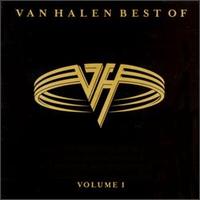
Best Of Van Halen, Vol 1 - 1996
In theory, a Van Halen greatest-hits collection should be easy to assemble, but The
Best of Van Halen, Vol. 1 proves that isn't the case. By trying to give the David Lee Roth
and Sammy Hagar eras equal space, they wind up not representing either particularly well.
The first eight songs run through several of Diamond Dave's biggest songs - "Ain't
Talkin' 'Bout Love," "Runnin' with the Devil," "And the Cradle Will
Rock," "Jump" and "Panama." It's hard to argue with any of the
choices, yet significant songs like "You Really Got Me," "Beautiful
Girls," "(Oh) Pretty Woman," "I'll Wait" and "Hot for
Teacher" are missing. Similarly, the Sammy era has many big hits - "Why Can't
This Be Love," "Dreams," "When It's Love," and "Right
Now" - but skips over hits like "Love Walks In," "Black and
Blue," and "Finish What Ya Started." Clearly, the collection would have
been better served if it had been assembled as a double-disc set, with Dave and Sammy
getting a disc apiece. Furthermore, the much-hyped reunion tracks with Roth, "Can't
Get This Stuff No More" and "Me Wise Magic," are a slight disappointment;
the band sounds good, but neither track contains a memorable hook. Also, the presence of
"Humans Being," one of Van Halen's worst tracks, is an insult, considering how
many great songs are missing. Nevertheless, Best Of, Vol. 1 remains a good single-disc
encapsulation of Van Halen's career, even if it isn't a definitive retrospective. -
Stephen Thomas Erlewine
01 - (1:42) Eruption
02 - (3:48) Ain't Talkin' 'Bout Love
03 - (3:37) Runnin' With The Devil
04 - (3:08) Dance The Night Away
05 - (3:35) And The Cradle Will Rock
06 - (3:29) Unchained
07 - (4:03) Jump
08 - (3:33) Panama
09 - (3:46) Why Can't This Be Love?
10 - (4:53) Dreams
11 - (5:40) When It's Love
12 - (5:23) Poundcake
13 - (5:23) Right Now
14 - (4:08) Can't Stop Lovin' You
15 - (5:09) Humans Being
16 - (5:17) Can't Get This Stuff No More
17 - (6:08) Me Wise Magic

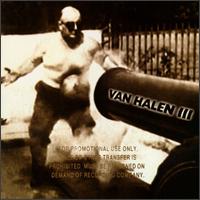
Van Halen III - 1998
The "III" in the title of Van Halen III refers to the unveiling of the third
incarnation of Van Halen, the post-Sammy Hagar lineup featuring former Extreme vocalist
Gary Cherone as lead singer. According to the party line, Van Halen ditched Sammy because
they wanted to try new musical and lyrical approaches that Hagar was reluctant to pursue.
And it is true that Van Halen III makes a slight break from his dunderheaded party rock,
but that's a difference that only hardcore fans will be able to hear. Less tired but no
more inspired than Balance, Van Halen III suffers from the same problems as Hagar-era Van
Halen - limp riffs, weak melodies, and plodding, colorless rhythms. On top of that, there
are layers of pretensions, from portentous lyrics to segmented song structures that don't
sound all that different from "Poundcake." Evidently, the group wanted to prove
that they could still rock more than they wanted to stretch their musical muscle. There
are a couple of new twists on the Van Halen format, whether it's funky breakdowns or
political consciousness, but it's all too familiar, since Cherone sounds uncannily similar
to Sammy, and Alex Van Halen and Michael Anthony remain the blandest rhythm section in all
of hard rock. That would be a shame if Eddie had a clear idea of where he wanted to take
the band, but he seems content to wallow in the big arena rock he has long since
exhausted, churning out faceless riffs and technically proficient guitar solos that never
expand the vocabulary he established 20 years ago. Van Halen III may showcase a new
version of Van Halen, but that doesn't make it a new beginning. - Stephen Thomas Erlewine
01 - (1:46) Neworld
02 - (6:32) Without You
03 - (5:32) One I Want
04 - (5:26) From Afar
05 - (5:29) Dirty Water Dog
06 - (7:45) Once
07 - (5:33) Fire In The Hole
08 - (5:44) Josephina
09 - (8:37) Year To The Day
10 - (1:27) Primary
11 - (5:44) Ballot Or The Bullet
12 - (6:06) How Many Say I

|